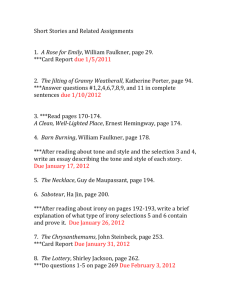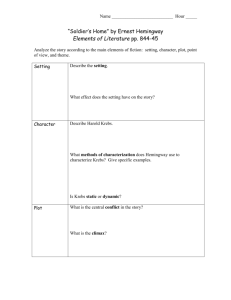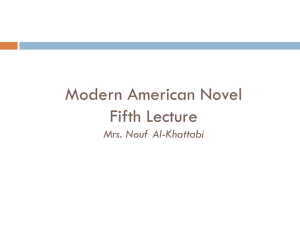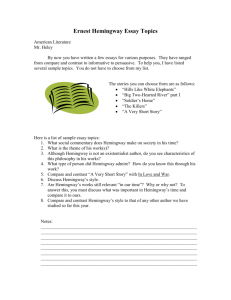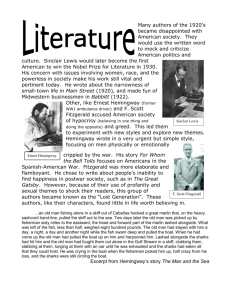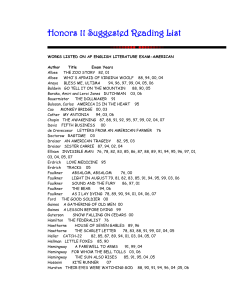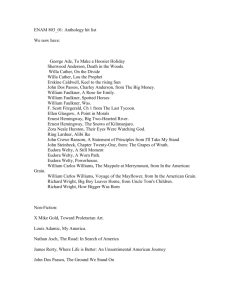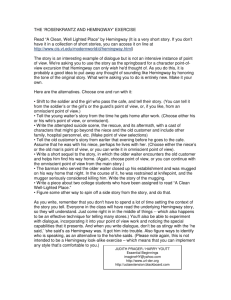Literary Works and Studies
advertisement
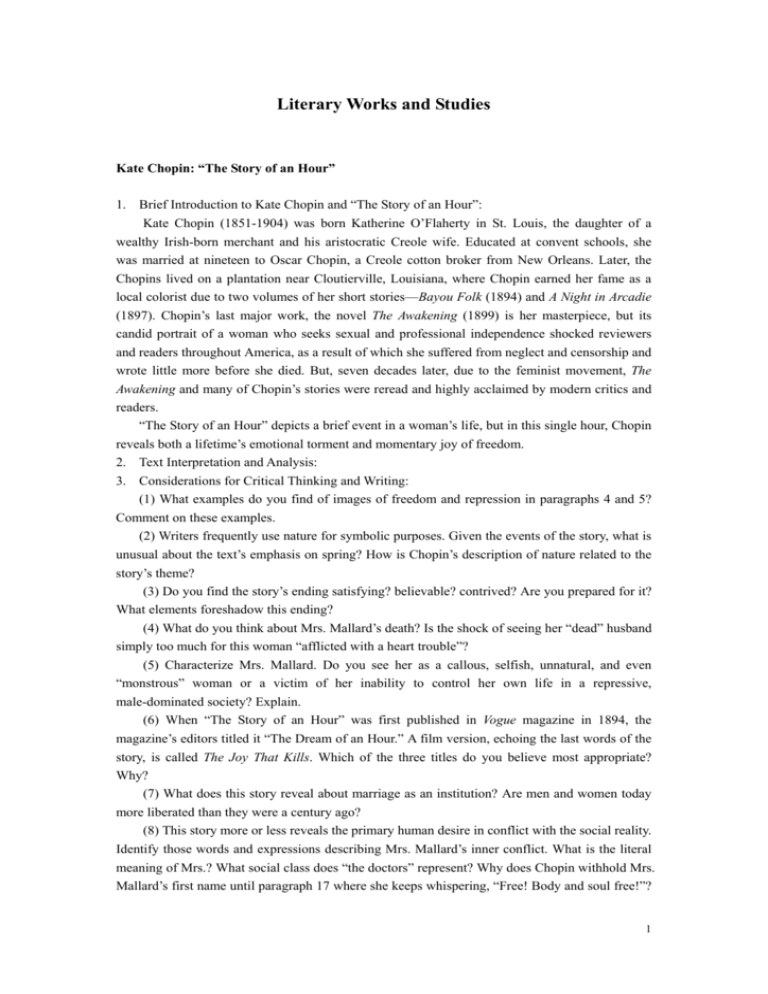
Literary Works and Studies Kate Chopin: “The Story of an Hour” 1. Brief Introduction to Kate Chopin and “The Story of an Hour”: Kate Chopin (1851-1904) was born Katherine O’Flaherty in St. Louis, the daughter of a wealthy Irish-born merchant and his aristocratic Creole wife. Educated at convent schools, she was married at nineteen to Oscar Chopin, a Creole cotton broker from New Orleans. Later, the Chopins lived on a plantation near Cloutierville, Louisiana, where Chopin earned her fame as a local colorist due to two volumes of her short stories—Bayou Folk (1894) and A Night in Arcadie (1897). Chopin’s last major work, the novel The Awakening (1899) is her masterpiece, but its candid portrait of a woman who seeks sexual and professional independence shocked reviewers and readers throughout America, as a result of which she suffered from neglect and censorship and wrote little more before she died. But, seven decades later, due to the feminist movement, The Awakening and many of Chopin’s stories were reread and highly acclaimed by modern critics and readers. “The Story of an Hour” depicts a brief event in a woman’s life, but in this single hour, Chopin reveals both a lifetime’s emotional torment and momentary joy of freedom. 2. Text Interpretation and Analysis: 3. Considerations for Critical Thinking and Writing: (1) What examples do you find of images of freedom and repression in paragraphs 4 and 5? Comment on these examples. (2) Writers frequently use nature for symbolic purposes. Given the events of the story, what is unusual about the text’s emphasis on spring? How is Chopin’s description of nature related to the story’s theme? (3) Do you find the story’s ending satisfying? believable? contrived? Are you prepared for it? What elements foreshadow this ending? (4) What do you think about Mrs. Mallard’s death? Is the shock of seeing her “dead” husband simply too much for this woman “afflicted with a heart trouble”? (5) Characterize Mrs. Mallard. Do you see her as a callous, selfish, unnatural, and even “monstrous” woman or a victim of her inability to control her own life in a repressive, male-dominated society? Explain. (6) When “The Story of an Hour” was first published in Vogue magazine in 1894, the magazine’s editors titled it “The Dream of an Hour.” A film version, echoing the last words of the story, is called The Joy That Kills. Which of the three titles do you believe most appropriate? Why? (7) What does this story reveal about marriage as an institution? Are men and women today more liberated than they were a century ago? (8) This story more or less reveals the primary human desire in conflict with the social reality. Identify those words and expressions describing Mrs. Mallard’s inner conflict. What is the literal meaning of Mrs.? What social class does “the doctors” represent? Why does Chopin withhold Mrs. Mallard’s first name until paragraph 17 where she keeps whispering, “Free! Body and soul free!”? 1 Interpret Mrs. Mallard’s motivations and behaviors in the light of Sigmund Freud’s psychoanalytic theory about the id, ego and superego. Hemingway: “A Very Short Story” 1. Brief Introduction to Hemingway and “A Very Short Story”: Ernest Hemingway (1899-1961), born in Oak Park, Illinois, bypassed college to be a cub reporter on the Kansas City Star. In World War I, as an eighteen-year-old volunteer ambulance driver in Italy, he was wounded in action. In 1922 he settled in Paris, then aswarm with writers; he later recalled that time in A Moveable Feast (1964). Hemingway’s first book, In Our Time (1925), is a collection of stories and sketches. His early novels, The Sun Also Rises (1926) and A Farewell to Arms (1929), established him as a master stylist, probably the most influential writer of American prose in the first half of the twentieth century. After publication of The Old Man and the Sea, he was awarded the Nobel Prize for literature in 1954. Hemingway’s heroes embody the writer’s own belief that although life may be followed by nada, or nothingness, strong individuals can embrace life and live it with dignity and honor. In1961, plagued by poor health and mental illness, Hemingway took his own life with a shotgun in his Idaho hunting lodge. According to novelist and critic Anthony Burgess, Hemingway changed the sound of English prose by struggling to write a “true simple declarative sentence.” Hemingway once explained how he achieved an intense compression by comparing his method to the principle of the iceberg: “There is seven-eighths of it under water for every part that shows. Anything you know you can eliminate and it only strengthens your iceberg. It is the part that doesn’t show. If a writer omits something because he does not know it then there is a hole in the story.” “A Very Short Story” is a brief account of Hemingway’s personal experience in Italy where, in the hospital after his 1918 wounding near the front, he and nurse Agnes von Kurowsky had a relationship that she soon brought to an end. In “A Very Short Story,” Hemingway covers a huge time span of years in only seven small paragraphs. The events of this story move very quickly. Throughout the entire story Hemingway uses the shortest, simplest sentences that are straightforward and describes what is happening in a concise manner. 2. Text Interpretation and Analysis: 3. Considerations for Critical Thinking and Writing: (1) The opening paragraph seems to have left out some important information such as the time, the place, the reason for his being carried to the roof, and the relationship between the soldier and Luz. There seems to be a restraint in the story. How do you respond to it? As you read along, are these information made clearer to you? (2) Obviously, the point of view in this story is technically third person (if it were first-person narration, it would read this way: “One hot evening in Padua they carried me up on the roof …”). But to whom do you think the viewpoint seems to be closer, the unnamed man or Luz? (3) Why is the soldier unnamed? What does the nurse’s name Luz sound like to you? Does it mean anything? (4) How do you interpret the soldier’s “holding tight to himself” and “taking the temperatures”? What type of man do you think he is? (5) “There were only a few patients, and they all knew about it. They all liked Luz.” What is 2 it that “they all knew about”? Why does Hemingway have the narrator immediately tell us “They all liked Luz”? Can you infer from the story what is the basis of the soldier’s relationship with Luz? Is there any evidence in the story of the depth of the soldier’s love? (6) Why doesn’t Luz return with the soldier rather than waiting on his “good job”? Doesn’t this condition make her seem a bit mercenary? Also, why are the restrictions on him seemingly so severe? Why does he not want to see his friends? Does Luz not trust him? Does he not trust himself? Do you think it is Luz who imposes these conditions or it is the soldier who volunteers them (note “they agreed …” and “It was understood …”)? (7) Paragraph six seems to indicate that Luz has shamefully betrayed the soldier. Do you think she is an unfeeling, cruel, and hypocritical “loose” woman? Do you see Luz’s own jilting by the major as just what she deserves? What does the setting in this paragragh reveal about Luz’s behavior and decision? (8) How do you interpret the last two sentences of the last paragraph? Do they indirectly convey the soldier’s pain or his immaturity? Do you agree that the soldier is obviously being made into a martyr, and Luz into a villain? (9) Discuss the story from the soldier’s point of view by stating a thesis like this: The poor nameless soldier is a victim and his fiancée, Luz, is a cold-hearted woman who makes him lose everything. Find evidences to support your ideas. (10) Discuss the story from Luz’s point of view and find evidences in the text that support her statement that “theirs had been only a boy and girl affair.” Ernest Hemingway: “Hills Like White Elephants” 1. Brief Introduction to the Story: Ernest Hemingway’s short story “Hills Like White Elephants” was first published in 1927. The whole story takes place during a forty-minute wait between trains. In the story an American man and “a girl” sit drinking beer in a bar by a train station in northern Spain discussing whether or not the girl should have an abortion. Because the man and the girl have different views on this subject, they argue continually throughout the story. However, in Hemingway’s skillful rendering, behind the argument hover the larger themes of love, mutability, and parental responsibility. The dramatic style, with its nearly invisible narrator recording almost like a camera eye, is vintage Hemingway. 2. Text Interpretation and Analysis: 3. Considerations for Critical Thinking and Writing: (1) The main topic of discussion between the man and the girl is never named. What is the “awfully simple operation”? Why is it not named? What different attitudes are taken toward it by the man and the girl? Why? (2) What does the dialogue tell you about the relationship between the man and woman? (3) Though the story consists mostly of dialogue, without adverbs revealing the tone of the remarks, Hemingway does make the dialogue contain strong emotional conflict. Describe the tone indicated in the dialogue and trace the various phases of emotion in the girl. (4) The conflict in the story is immediate and apparent. Yet there is a deeper and unspoken one. What is it? 3 (5) What is the point of the girl’s comparison of the hills to white elephants? Why does the author use it for his title? (6) What purpose does the setting serve—the hills across the valley, the treeless railroad tracks and station? What does it reveal about the two characters’ different personality? (7) The point of view of this story is objective. Does this mean that we cannot tell whether the sympathy of the author lies more with one character than with the other? What would have been lost if Hemingway had used an omniscient (all-knowing) point of view? (8) Loving relationship between man and woman is always explored and examined by writers. What message or theme do you think Hemingway tries to convey in this story? Ernest Hemingway: “A Clean, Well-Lighted Place” 1. Brief Introduction to the Story: This story does not have a conventional plot in which characters grow and change and conflicts are resolved. All that “happens” is that an old man sits drinking in a café while the two waiters talk about him and about themselves. When the old man leaves, we follow the older of the two waiters to an all-night bar where he thinks about the restless night he will spend in a lonely room and an empty bed. For this reason, it might be argued that in this story language takes on more of a central role than it plays in other writers’ stories. For all its brevity and simplicity, the impact of the story is tremendous. It lends readers a glimpse into rather than at life which jars them into somber thoughts about the needs and desires of youth and old age, and, more importantly, the stark tragedy of loneliness. 2. Text Interpretation and Analysis: 3. Considerations for Critical Thinking and Writing: (1) Compare the younger waiter and the older waiter in their attitudes toward the old man and the café. What does the young waiter believe in? Does the older waiter believe in anything? Characterize each of them. (2) Why does the older waiter so well understand the old man’s need for a café? What does the café represent for the two of them? (3) Reread the concluding part of the story. What makes the older waiter reluctant to go to bed? Comment especially on his meditation upon nada. (4) Discuss the parodies of the Lord’s Prayer and the Hail Mary in paragraph 76. How might they help you understand the tone and the theme of the story? (5) What does Hemingway indicate by ending the story with a very simple sentence “Many must have it”? (6) The story’s dialogue is presented in alternating exchanges of very brief sentences. What is the effect of these clipped exchanges? (7) In The Writer’s Art of Self-Defense, Jackson J. Benson states, “Blindness versus awareness is Hemingway’s most pervasive theme, and it is borne on a rippling wave of irony into almost everything he writes.” Of the two waiters in the story, which one do you think is “blind,” and which one is “aware”? And how? Explain. 4 Nathaniel Hawthorne: “Young Goodman Brown” 1. Brief Introduction to Nathaniel Hawthorne and “Young Goodman Brown”: Nathaniel Hawthorne (1804-1864) was born in the clipper-ship seaport of Salem, Massachusetts, son of a merchant captain and grandson of a judge at the notorious Salem witchcraft trials. After graduating from Bowdoin College in 1825, Hawthorne returned to live in his mother’s house in Salem, developing his ability as a writer for twelve years. After he married, he moved to Concord where Ralph Waldo Emerson and Henry David Thoreau were his neighbors. Unlike them, however, his ideas about human nature were rarely optimistic. In The Scarlet Letter (1850) and The House of the Seven Gables (1851), Hawthorne wrote of conflicted characters, with hearts and souls torn by guilt, sin, pride, and isolation. His stories probe the dark side of human nature and frequently paint a world that is virtuous on the surface but “one stain of guilt, one mighty blood spot” beneath. Indeed, his neighbor and good friend Herman Melville praised “the power of blackness” found in Hawthorne’s fiction. Hawthorne referred to his own work as romance. He used this term to mean not an escape from reality, but rather a method of confronting “the depths of our common nature” and “the truth of the heart.” His stories often emphasize the ambiguity of human experience. For example, the reader is left to wonder whether Goodman Brown actually saw a witches’ coven or dreamed a dream. The story “Young Goodman Brown” was first published in 1835. It is a typical allegorical story where the moral absolutism of the Puritans contributes to the suffering of a man because he cannot accept the flawed complexity of the human condition. As Melville once said, It is a tale “as deep as Dante.” “Goodman” was a title of respect, but at a social rank lower than “gentleman.” “Goody” (or “Goodwife”) was the feminine equivalent. Deacon Gookin in the story is a historical personage (1612-1687), as are also Goody Cloyse, Goody Cory, and Martha Carrier, all three executed at the Salem witchcraft trials in 1692. 2. Text Interpretation and Analysis: 3. Considerations for Critical Thinking and Writing: (1) Consider the historical background of this story. What is the point of Hawthorne using the names of actual persons (Goody Cloyse, Goody Cory, Deacon Gookin, Martha Carrier) and places (Salem village, Boston, Old South Church)? (2) What is the significance of Young Goodman Brown’s name? Why is Brown’s wife Faith “aptly named”? (3) What is the symbolic value of the forest in this story? How are the descriptions of the forest contrasted with those of Salem village? (4) Characterize Young Goodman Brown at the beginning of the story. Why does he go into the forest? What does he mean when he says “Faith kept me back a while”? (5) What purpose do Faith’s pink ribbons serve in the story? Does the color “pink,” a mixed color, have symbolic meanings? (6) What do you make of the fact that the strange man in the woods closely resembles Brown himself (paragraphs 13, 32)? (7) What is the point of view of the story? Where does it change, and what is the result of this 5 change (Compare it with that of Katherine Mansfield’s “Miss Brill”)? (8) “Had Goodman Brown … only dreamed a wild dream of a witch-meeting?” How are you to answer this question? As has been realized, Hawthorne’s language is highly symbolic and ambiguous. Find other places in the story where you find the interpretation ambiguous, and explain its effect. (9) Discuss Young Goodman Brown’s journey as an inward, psychological one in the light of Sigmund Freud’s psychoanalytic theory about the id, ego, and superego. Scott Fitzgerald: “The Great Gatsby” (Chapter III) 1. Brief Introduction to Scott Fitzgerald and “The Great Gatsby”: Francis Scott Fitzgerald (1896-1940) was born in St. Paul, Minnesota. He established himself as a leading spokesman of “The Jazz Age” (his own phrase) with the critical and financial success of his early works This Side of Paradise (1920), a loosely autobiographical novel; Flappers and Philosophers (1920), a collection of stories; The Beautiful and the Damned (1922), a disappointing second novel; and Tales of the Jazz Age (1922). The Great Gatsby (1925), which many consider his masterpiece and makes him one of the greatest American novelists, was followed by All the Sad Young Men (1926), a third collection of stories. In 1934 Fitzgerald’s fourth novel Tender Is the Night was published. The 1930s brought relentless decline for Fitzgerald with a series of misfortunes: his reputation declined, his wealth fell, his health failed, and what’s more, his wife Zelda had suffered from some serious mental breakdowns which confined her in a sanitarium for the rest of her life. Alcoholism, loneliness and despair combined to ruin him. He died in 1940 of a heart attack, leaving his last novel The Last Tycoon unfinished. Most critics have agreed that Fitzgerald is both an insider and an outsider of the Jazz Age. This doubleness or irony is one of the distinguishing marks as a writer and helps Fitzgerald to present a panorama of the Jazz Age with a deep insight. In his novels and stories, especially The Great Gatsby, Fitzgerald never spared an intimate touch to deal with the bankruptcy of the American Dream, which is highlighted by the disillusionment of the protagonists’ personal dreams due to the clashes between their romantic vision of life and the sordid relentless reality. The Chapter Three of The Great Gatsby describes a big party given by Gatsby. Ironically, in the story the host seems exceedingly courteous but keeps himself at distance from his guests. The guests come eagerly but are indifferent or contemptuous of their host. The wonderful description vividly evokes both the romance and the sadness of that strange and fascinating era. 2. Text Interpretation and Analysis: 3. Considerations for Critical Thinking and Writing: (1) From whose point of view is the story narrated? Is the narrator reliable? Why or why not? (2) What difference does living in “East Egg” or “West Egg” make? What does the difference reveal about the social values or the spirit of the 1920s? (4) Explain the implied meaning of the sentence: “It was testimony to the romantic speculation he inspired that there were whispers about him from those who had found little that it was necessary to whisper about in this world.” What does it reveal about human nature? (3) What implied meaning can you get from reading the paragraph describing the end of the 6 party “The caterwauling horns had reached a crescendo and I turned away….his hand up in a formal gesture of farewell”? (4) What is the mood or atmosphere in the story? How does Fitzgerald create it? What ironies have you recognized in it? (5) What is the “American Dream”? How does Gatsby, as well as Fitzgerald himself, illustrate the paradox of it? William Faulkner: “A Rose for Emily” 1. Brief Introduction to William Faulkner and “A Rose for Emily”: William Faulkner (1897-1962) was born in New Albany, Mississippi, into an old southern family and raised in the isolated town of Oxford, the home of the University of Mississippi, where, except for his service in World War I and some time in New Orleans and Hollywood, he spent the rest of his life. “I discovered my own little postage stamp of native soil was worth writing about, and that I would never live long enough to exhaust it.” Faulkner published his first novel, Soldier’s Pay, in 1926. His major work was written in the late 1920s and the 1930s, when he created an imaginary county adjacent to Oxford, calling it Yoknapatawpha County and chronicling its history in a series of experimental novels, including The Sound and the Fury (1929), As I Lay Dying (1930), Sanctuary (1931), Light in August (1932), Absalom, Absalom! (1936), and The Hamlet (1940). In 1952, Faulkner was awarded the Nobel Prize for Literature. Many of Faulkner’s novels and stories blend the grotesquely comic with the appallingly tragic. “A Rose for Emily,” Faulkner’s first nationally published short story (published in Forum in April, 1930), presents a story of love and respect as told by citizens of Yoknapatawpha County. In it are examples of several of Faulkner’s artistic preoccupations and techniques, the exploration of psychological reality, the social structure and mores of a Southern community, the nature of time, and the relation of the past to the present. 2. Yoknapatawpha County, the “mythical kingdom”: Most of Faulkner’s works are set in the American South, with his emphasis on the Southern subjects and consciousness. Of the nineteen novels and seventy-five short stories, fifteen novels and many of his stories are about people from a small region in Northern Mississippi, Yoknapatawpha County, which is actually an imaginary place based on Faulkner’s childhood memory about the place where he grew up, the town of Oxford in his native Lafayette County. With his rich imagination, Faulkner turned the land, the people and the history of the region into a literary creation and a mythical kingdom. There is no region in the U. S. that contains as much beauty, violence, passion, courage and, finally, tragedy, as the American South. And in the twentieth century, there is no novelist who more powerfully and eloquently represents this region in his fiction than William Faulkner. 3. Quotation from Faulkner’s Nobel Prize Acceptance Speech (1950): I believe that man will not only endure: he will prevail. He is immortal, not because he 7 alone among creatures has an inexhaustible voice, but because he has a soul, a spirit capable of compassion and sacrifice and endurance. The poet’s, the writer’s, duty is to write about these things. It is his privilege to help man endure by lifting his heart, by reminding him of the courage and honor and hope and pride and compassion and pity and sacrifice which have been the glory of his past. The poet’s voice need not merely be the record of man, it can be one of the props, the pillars to help him endure and prevail. 4. Text Interpretation and Analysis: 5. Considerations for Critical Thinking and Writing: (1) Discuss the effect of the final paragraph of the story. Do you feel shocked? Why isn’t it placed at the very beginning of the story? (2) One of the most characteristic way of Faulkner’s structuring his stories is to fragment the chronological time. He deliberately breaks up the chronology of his narrative by juxtaposing the past with the present, as could be seen in “A Rose for Emily.” Arrange the order of the story’s events and contrast it with the order of the story’s narration, and discuss the effect of Faulkner’s plotting. (3) Faulkner uses a number of gothic elements in this story. Find as many examples as you can. How do these elements forward the plot and establish the atmosphere? (4) Miss Emily is clearly the story’s protagonist. Then, what characters or forces in the story act or function as antagonist(s)? What are you to make of the fact that Homer Barron is a construction foreman and a northerner? (5) Who is the narrator of the story? Does he reveal his attitude in the narration? Why do you think the author uses we rather than I as the narrator? (6) Reading the story carefully, and you can find various patterns of juxtaposition at work, such as the South vs. the North, the old vs. the young, the past vs. the present, the aristocrat vs. the common, the individual vs. the community, etc. Focus on the juxtaposition of the old with the young, and find examples in the story that reveal their different value systems or human concerns. (7) In the story, the narrator says, “Alive, Miss Emily had been a tradition, a duty, and a care.” Some critics have further suggested that Miss Emily Grierson is a kind of symbol of the Old South, the last defender of its outdated ideas of chivalry, formal manners, and tradition. Comment on this interpretation. How would you understand Miss Emily? (8) In the story the protagonist Miss Emily is clearly portrayed as an isolated recluse, insane and grotesque. Then is she treated with contempt or disgust? Why or why not? In what way is she linked to the community and forms part of it? Ralph Ellison: “The Invisible Man” (Chapter I, “Battle Royal”) 1. Brief Introduction to Ralph Ellison and “Battle Royal”: Born in Oklahoma to an activist mother and an intellectual father, Ralph Ellison (1914-1994) was well grounded in literary and social matters by the time he entered Tuskegee Institute to study music in 1933. Finding the conservatism and accommodationism of Tuskegee limiting, Ellison read modernist poets like T. S. Eliot and soon moved to New York in 1936, where he met writers Langston Hughes and Richard Wright. Inspired by Wright and by the works of Conrad, 8 Dostoyevsky, and other writers of fiction, Ellison began drafting his novel Invisible Man while serving in the merchant marine during World War II. After having been working on it for five years, Ellison published Invisible Man in 1952. His masterpiece was instantly and widely acclaimed. It won the National Book Award, an honor rarely given to a first novel, and has become a classic of modern American fiction. Ellison has also written many short stories, reviews and articles, a number of which are included in the collection Shadow and Act (1964). “Battle Royal,” published in 1947 as a short story, became the first chapter of Invisible Man. It concerns the beginning of the protagonist’s long struggle for an adult identity in a world made corrupt by racial prejudice. 2. Text Interpretation and Analysis: 3. Considerations for Critical Thinking and Writing: (1) How is the opening section (paragraphs 1-4) connected to the story? To the last paragraph? Comment on the narrator’s statement in paragraph 1 that he is an invisible man. (2) Why do the narrator’s grandfather’s last words cause so much anxiety in the family? What does his grandfather’s deathbed advice mean? (3) What is the symbolic significance of the naked blonde? What details reveal that she represents more than a sexual tease in the story? (4) How do you interpret the narrator’s dream (para. 104-106)? Why would his grandfather be laughing? (5) Describe the appropriateness of the point of view employed by Ellison in the story. What would be different if the story were told from a third-person point of view? (6) “Battle Royal” can be divided into six sections. Identify these sections and explain what the narrator learns in each section and how he changes in response to what he learns. (7) Ellison renders many objects and scenes in “Battle Royal” profoundly symbolic. Identify these objects (blindfold, for example) and scenes and explain their symbolic meanings. (8) Discuss how the protagonist’s expectations are similar to the American dream. Do you believe in the American dream? Do you have the same problems and feelings in your life or when you were young? Flannery O’Connor: “A Good Man Is Hard to Find” 1. Brief Introduction to Flannery O’Connor and “A Good Man Is Hard to Find:” Mary Flannery O’Connor (1925-1964) was born to a prosperous Catholic family in Savannah, Georgia, and spent most of her adult life on a farm near the town of Milledgeville. She died of Lupus, the immune system disease that killed her father, when she was only thirty-nine years old. O’Connor is an extraordinary post-war American writer who, in the short time that she lived, wrote two novels (Wise Blood, 1952 and The Violent Bear It Away, 1960) and thirty-one stories, many of which have received highest praise from literary critics. A devout Catholic and determined regionalist, O’Connor has her literary imagination deeply rooted in religious convictions. She never hesitates to place her characters in the “Christ-haunted” southern Protestant Bible belt, her native Georgia soil, and spares no effort on the portrayal of the incompleteness of human beings without religion. As a result, most of her works turn out to be a distillation of the Christian experience and path toward revelation and salvation. In her particular rendering, the 9 journeys, though painful, awesome, and violent, often ending in humiliation or even death, always eventually lead her arrogant and imperceptive characters toward the realization of true Christian values or the salvation of the soul. The spiritual pilgrimage that one must struggle through to achieve eternal salvation is perhaps best brought out in “A Good Man Is Hard to Find.” “A Good Man Is Hard to Find” was first published in 1955. In the story, O’Connor, by using a family’s journey to Florida as the vehicle, takes the protagonist, the grandmother, to the confrontation with ultimate evil and ultimate reality that will violently strip away all pretext of superficiality and lead her to the eternal salvation. 2. Text Interpretation and Analysis: 3. O’Connor’s Ideas of Grotesque and Violence: O’Connor believes that people in the modern world are not following the true path and thus the serious writer’s task is to make them see their conditions for what they really are. With a strong faith in her religion and her art, O’Connor states in Mystery and Manners (1961) that “writers who see by the light of their Christian faith will have, in these times, the sharpest eyes for the grotesque, for the perverse, and for the unacceptable. ” In her writing, O’Connor consciously develops a conscious aesthetic for grotesquery and creates an art of distortion, hoping to show a world not only full of sordidness and real evil but also, more importantly, love and goodness of the most powerful kind as revealed through violence. Confident of her religious ideas, O’Connor sees herself as a prophetic writer whose authorial strategy is to shock: The novelist with Christian concerns will find in modern life distortions which are repugnant to him, and his problem will be to make these appear as distortions to an audience which is used to seeing them as natural; and he may well be forced to take ever more violent means to get his vision across to this hostile audience. When you can assume that your audience holds the same beliefs you do, you can relax a little and use more normal means of talking to it; when you have to assume that it does not, then you have to make your vision apparent by shock---to the hard of hearing you shout, and for the almost-blind you draw large and startling figures. Therefore, according to O’Connor, violence is strangely capable of returning her characters to reality and preparing them to accept their moment of grace. She believes that only by placing her characters into “extreme situations” can she force them to confront the problem of evil and to work out their salvation. 4. Considerations for Critical Thinking and Writing: (1) Consider O’Connor’s early description of setting or scene in the story. How do they foreshadow what will happen in the end of the story? (2) How does the grandmother’s use of the words pickaninny and niffer contrast with her very proper appearance and her preoccupation with manners? What does her use of these words reveal about her? (3) Explain the irony in this statement: “In case of an accident, anyone seeing her dead on the highway would know at once that she was a lady.” (4) When the grandmother’s head clears for an instant (paragraph 137), what does she suddenly understand? (5) Characterize the Misfit. Can he simply be regarded as insane? What is the purpose or 10 nature of his killing? How can his killing and his remarks that “It’s no real pleasure in life” be related to the theme? (6) Describe the tone of the narrator’s voice. Is it humorous? Sympathetic? Sarcastic? Detached? Somber? Or what? Explain its appropriateness in conveying the theme of the story. (7) In a book Flannery O’Connor edited by Harold Bloom, Frederick Asals points out in his essay “The Double” that the grandmother and many other characters in O’Connor’s works “…are among the least introspective in modern fiction, with minds at once unaware and so absurdly assured that they have refused to acknowledge any deeper self.” Read this story carefully. Identify the grandmother’s words and behaviors that reveal about her being “unaware” and refusing to look deeper into herself. (8) In Mystery & Manners, O’Connor writes that the grandmother has “a good heart,” even though she “is a hypocritical old soul,” and that the victory she experiences is one that “we do not allow to someone altogether bad.” And she goes on to suggest that in reading “A Good Man Is Hard to Find,” the reader “should be on the lookout for such things as the action of grace in the grandmother’s soul, and not for the dead bodies.” Then, in what part of the story do you see “the action of grace”? Do you think the story does leave you with a special kind of triumph of salvation for the protagonist? Alice Walker: “Everyday Use” 1. Brief Introduction to Alice Walker and “Everyday Use”: Alice Walker (1944- ) was born in Eatonton, Georgia. She attended Spelman College in Atlanta, and in 1965 she finished her undergraduate work at Sarah Lawrence College. Then she became active in the civil rights movement. Later she taught writing and literature at Jackson, Tougaloo, Wellesley and Yale. She has edited and published fiction, poetry, and biography, and she received a Guggenheim Fellowship in 1977. Her best novel, The Color Purple (1982), won a Pulitzer Prize and the National Book Award. She has said that her chief concern is “exploring the oppressions, the insanities, the loyalties, and the triumphs of black women.” One of Walker’s goals in writing is to further the process of reconnecting people to their ancestors. She has said that “it is fatal to see yourself as separate” and that if people can reaffirm the past, they can “make a different future.” “Everyday Use,” first published in 1973, is about the conflict between a mother and a daughter over their heritage. This story is not simply a “brilliant satire on the educated black woman Dee who has discovered her roots—roots that will never be a living part of her, will never be for everyday use.” On a deeper level, it is a “rich portrait of a strong woman who knows herself and of a life represented by her relationship to her daughter Maggie and to her ancestors—a life for everyday use.” It is an interesting examination of the clashing cultural values, aiming at the definition of the concept of heritage. 2. Text Interpretation and Analysis: 3. Considerations for Critical Thinking and Writing: (1) This story is narrated by the mother. Discuss the appropriateness of this point of view. (2) At the end of the story, Dee tells her sister, “It’s really a new day for us. But from the way you and Mama still live you’d never know it.” What does Dee mean? And how do the mother and sister respond? 11 (3) In paragraph 76 the mother says, “When I looked at her like that something hit me in the top of my head and ran down to the soles of my feet.” What “hit” the mother? what does she understand at this moment? (4) Characterize the mother and her two daughters, Dee and Maggie. (5) Discuss the setting of the story. How does it help reflect the contrasting attitudes of the mother and Dee? (6) Identify the conflict of values at work in Maggie’s and Dee’s joint desire for the quilts. Why are the quilts important? What do they symbolize? What values does the mother’s ultimate decision reflect? 12

